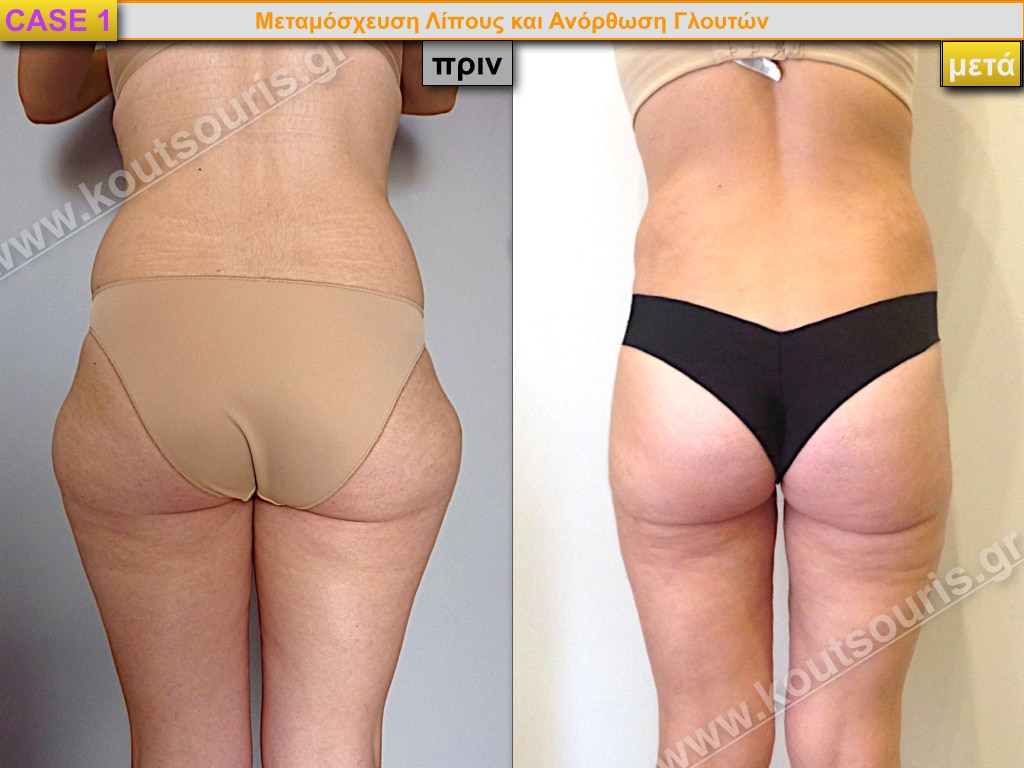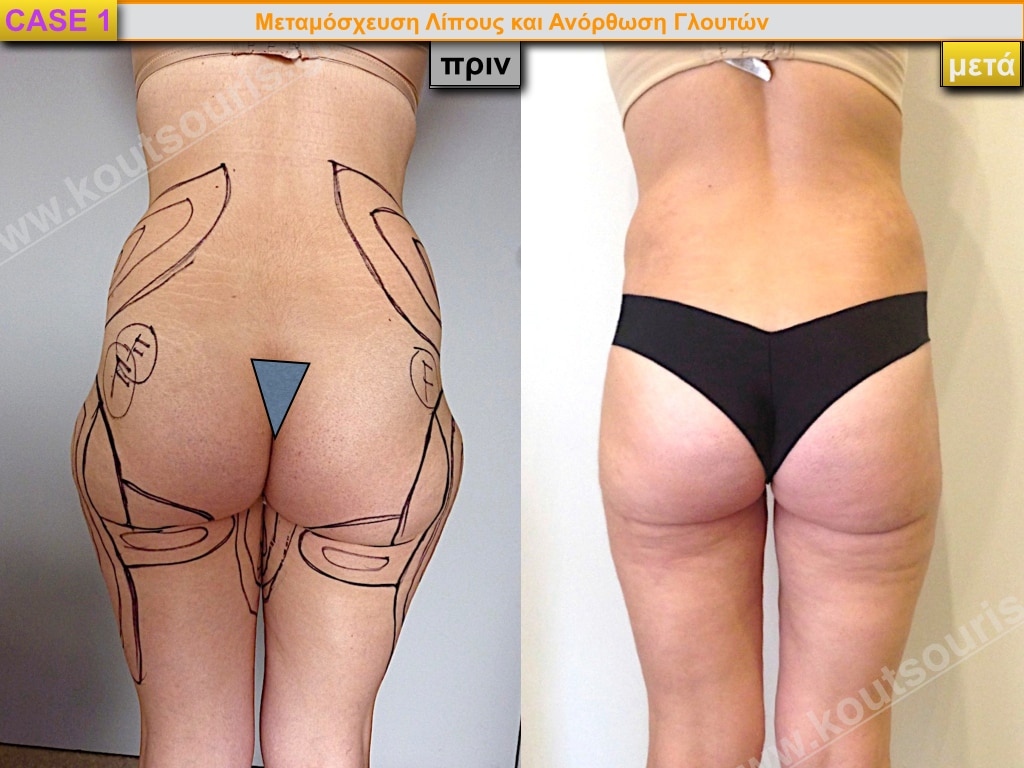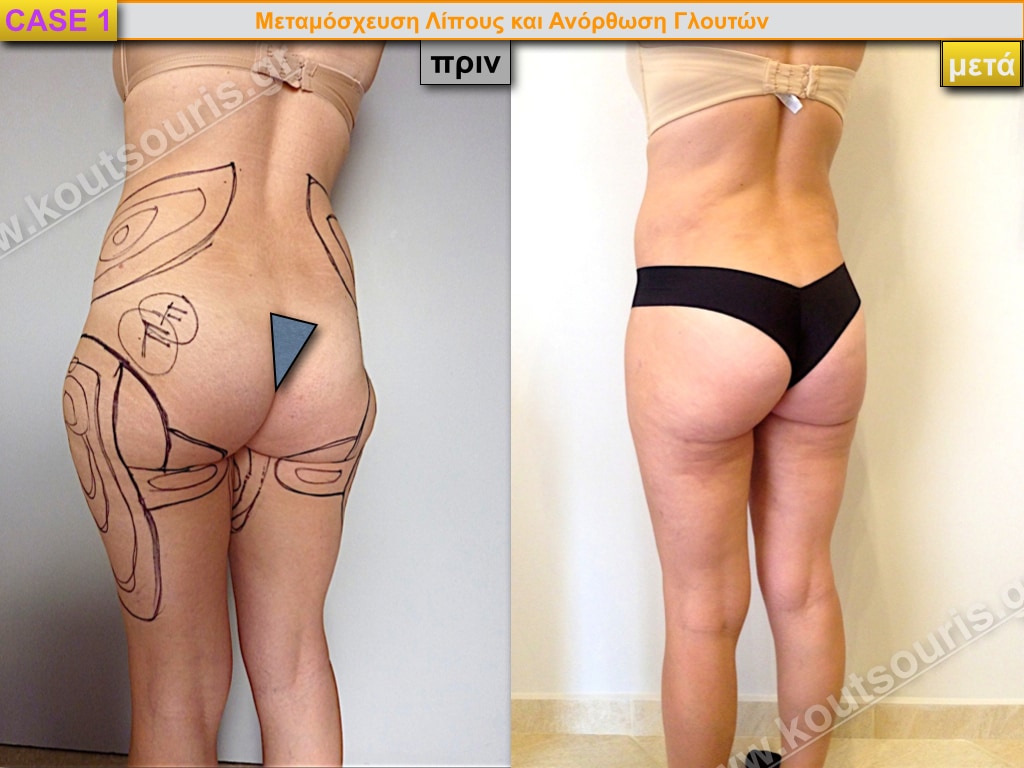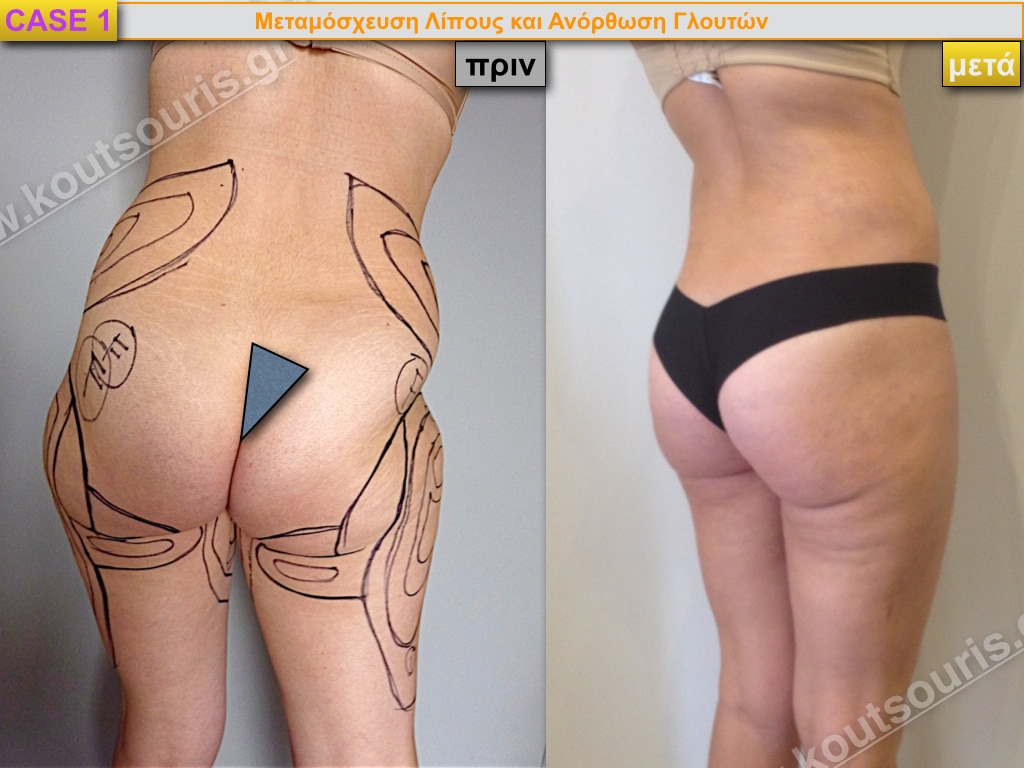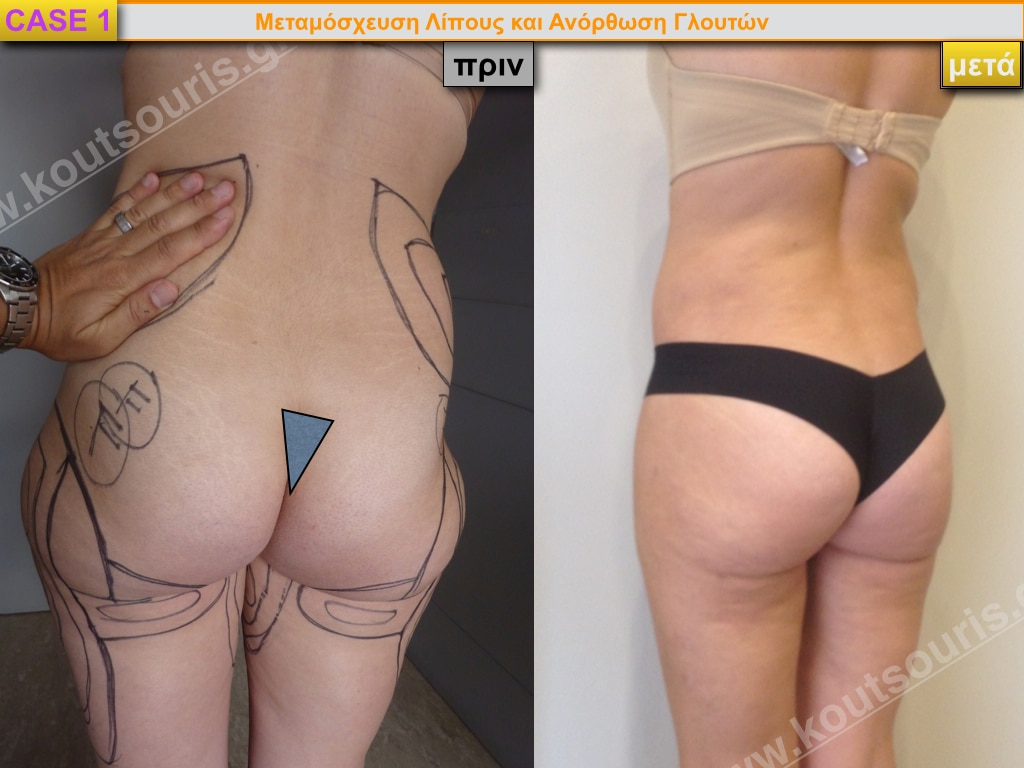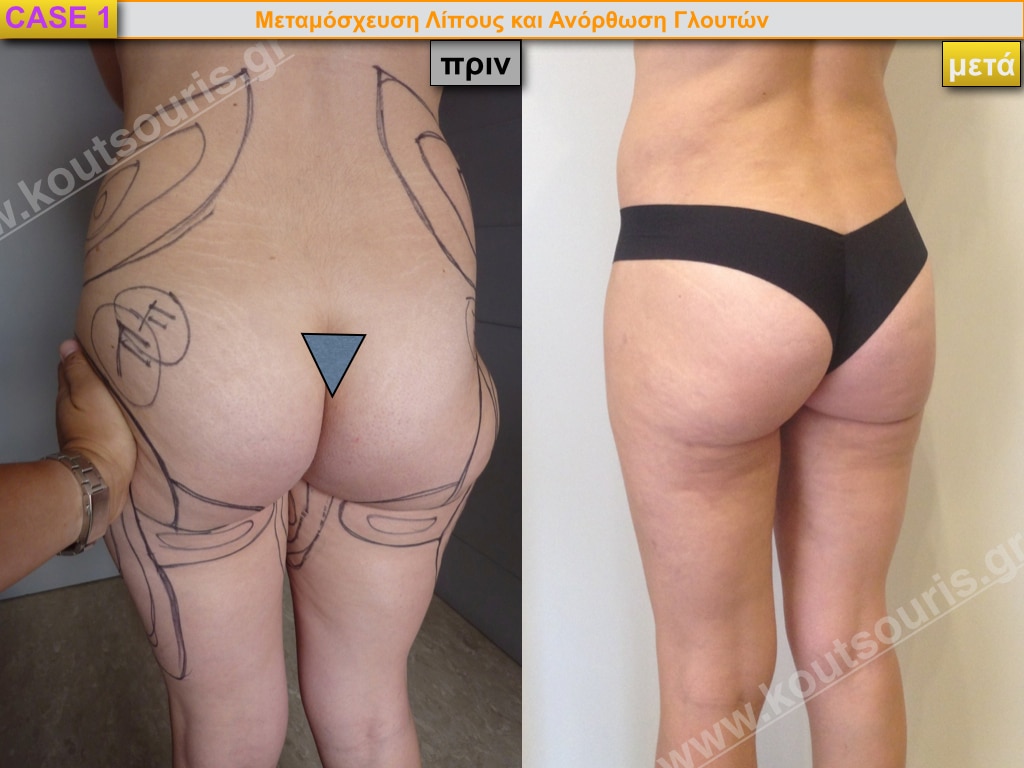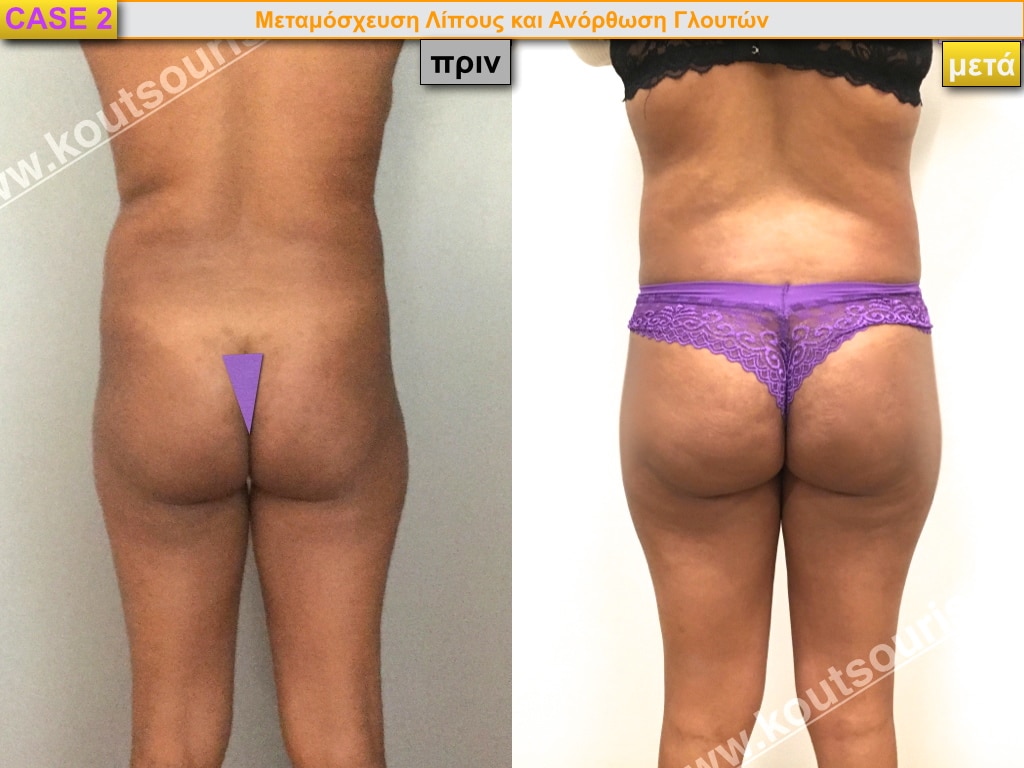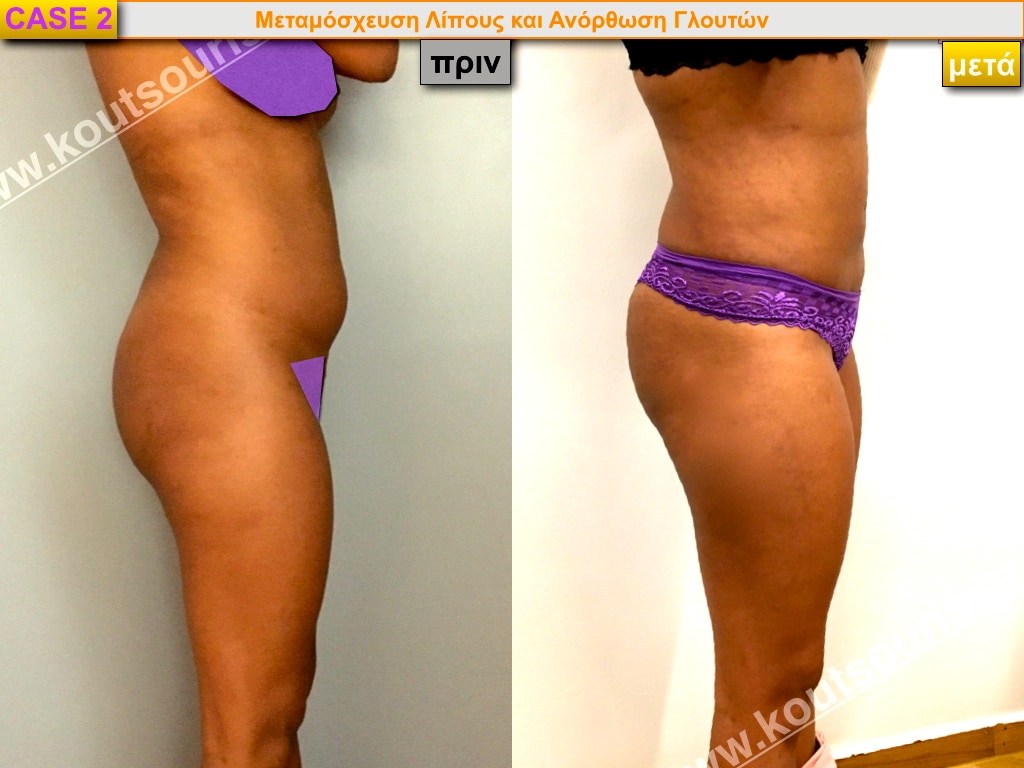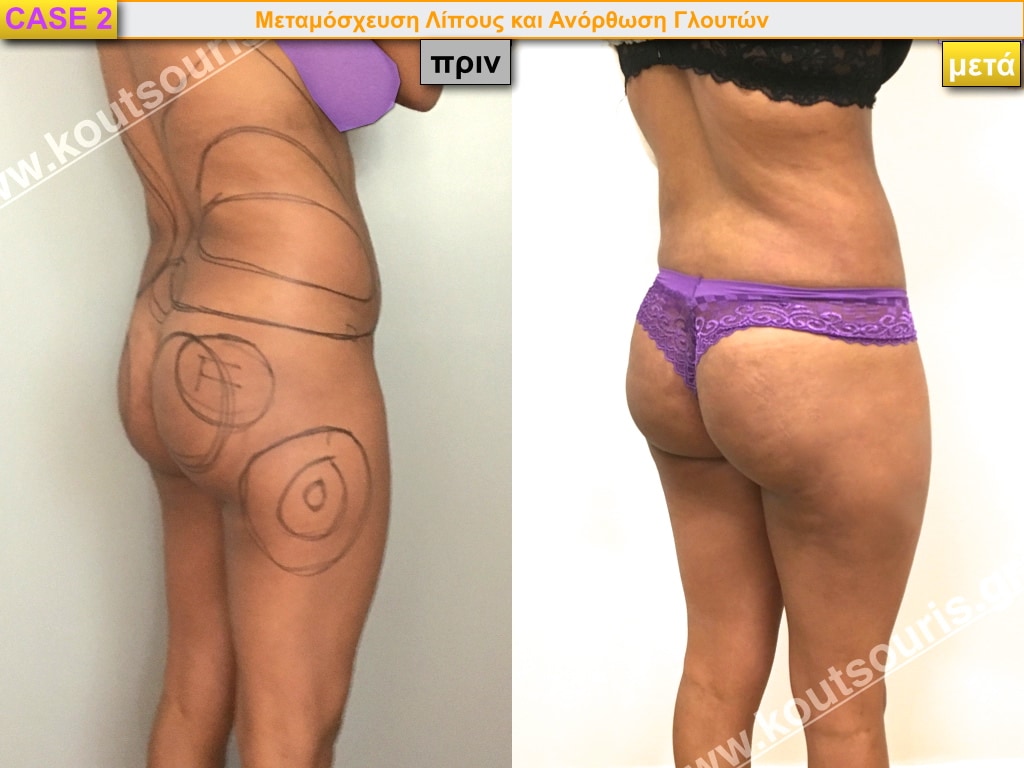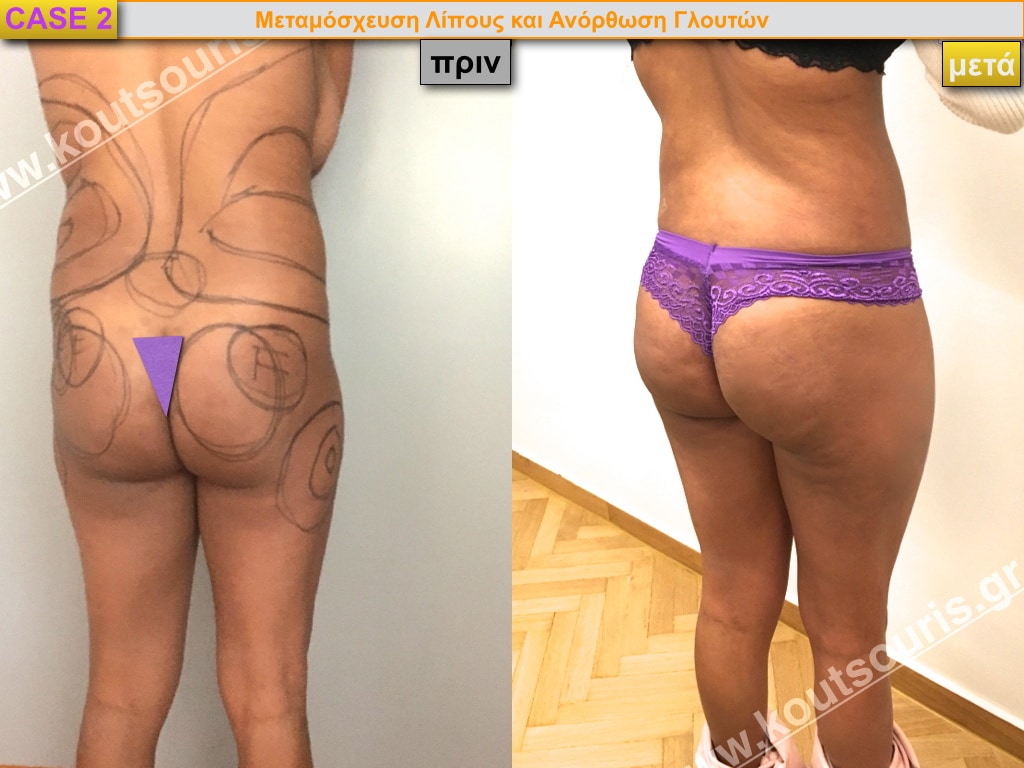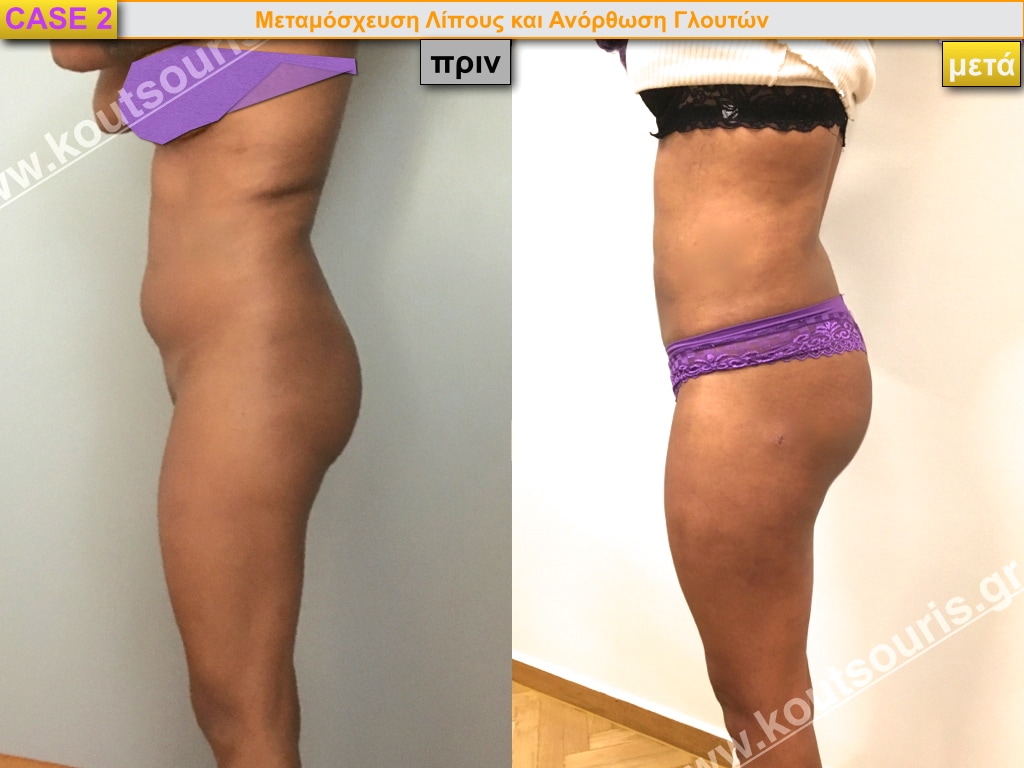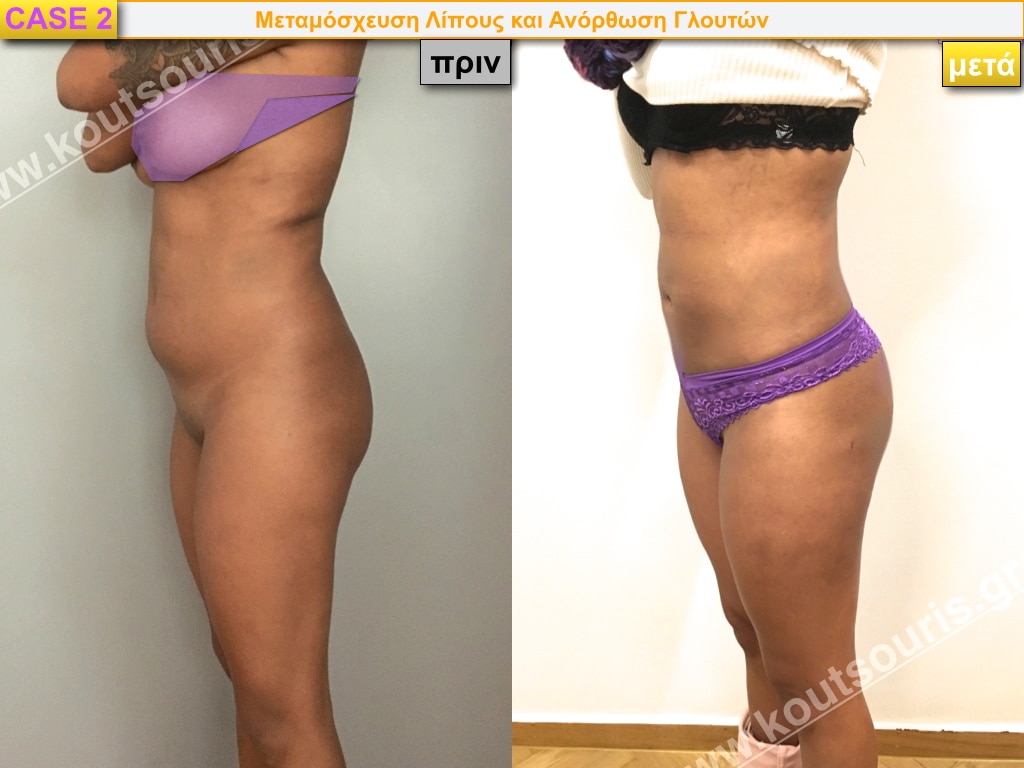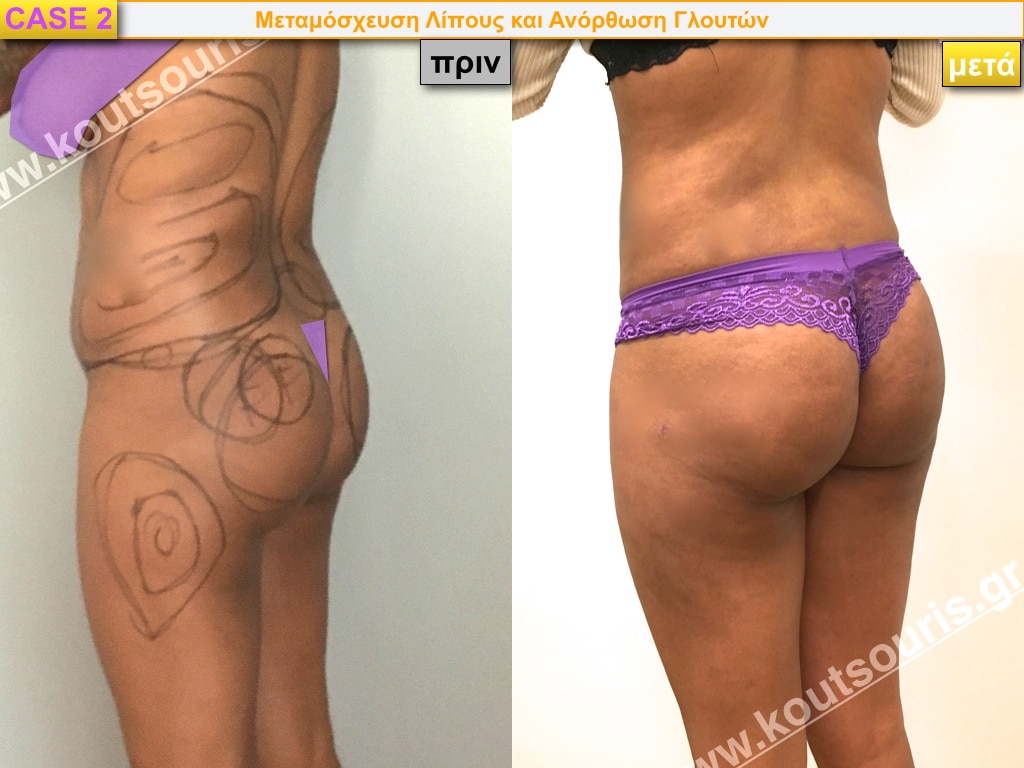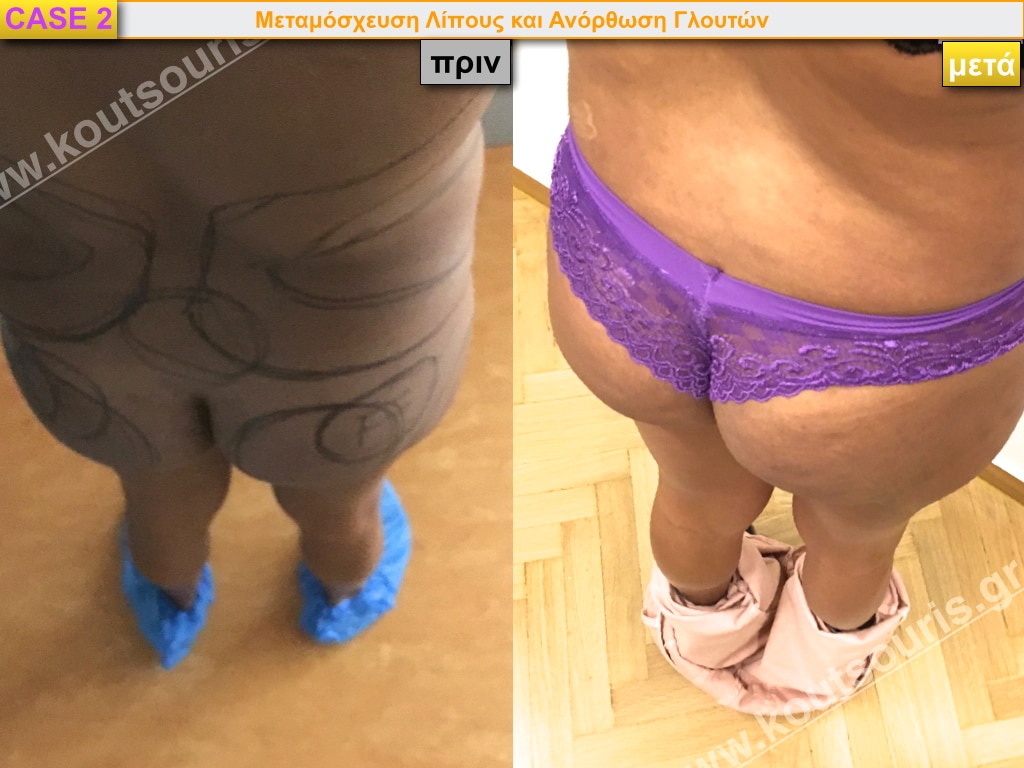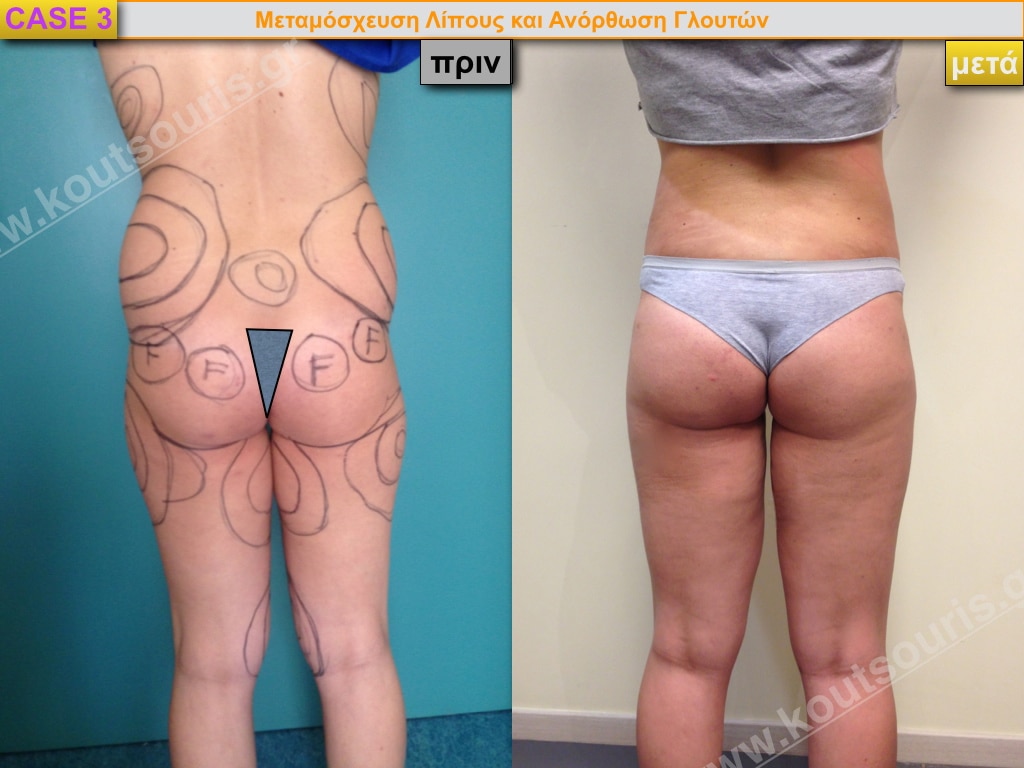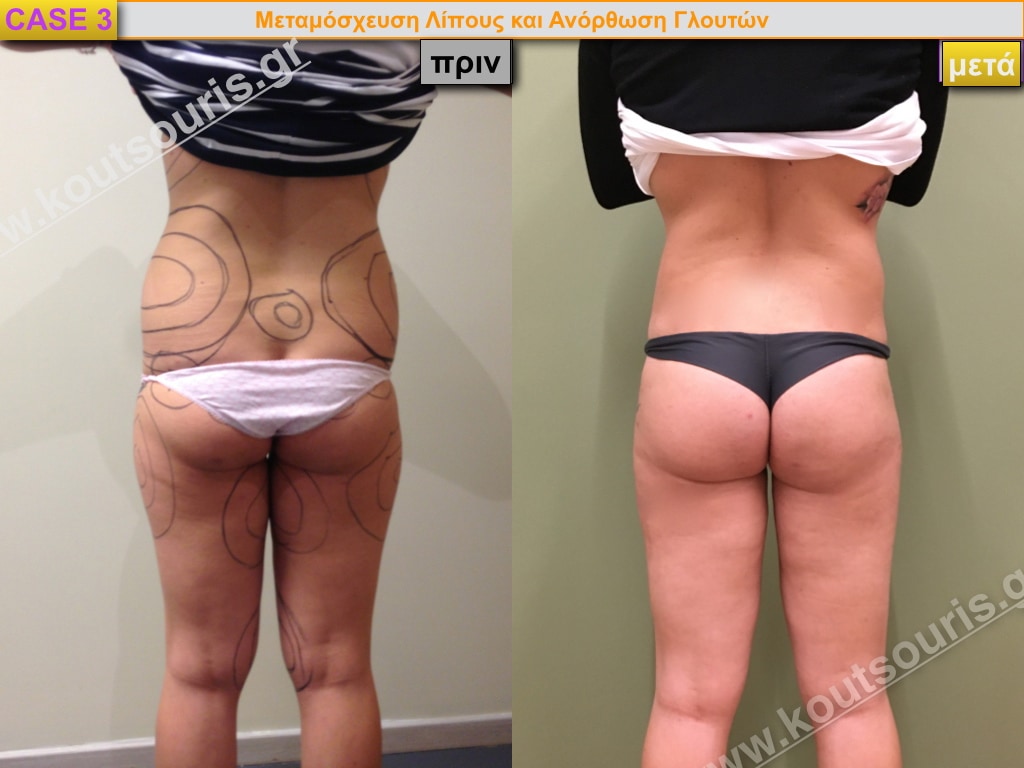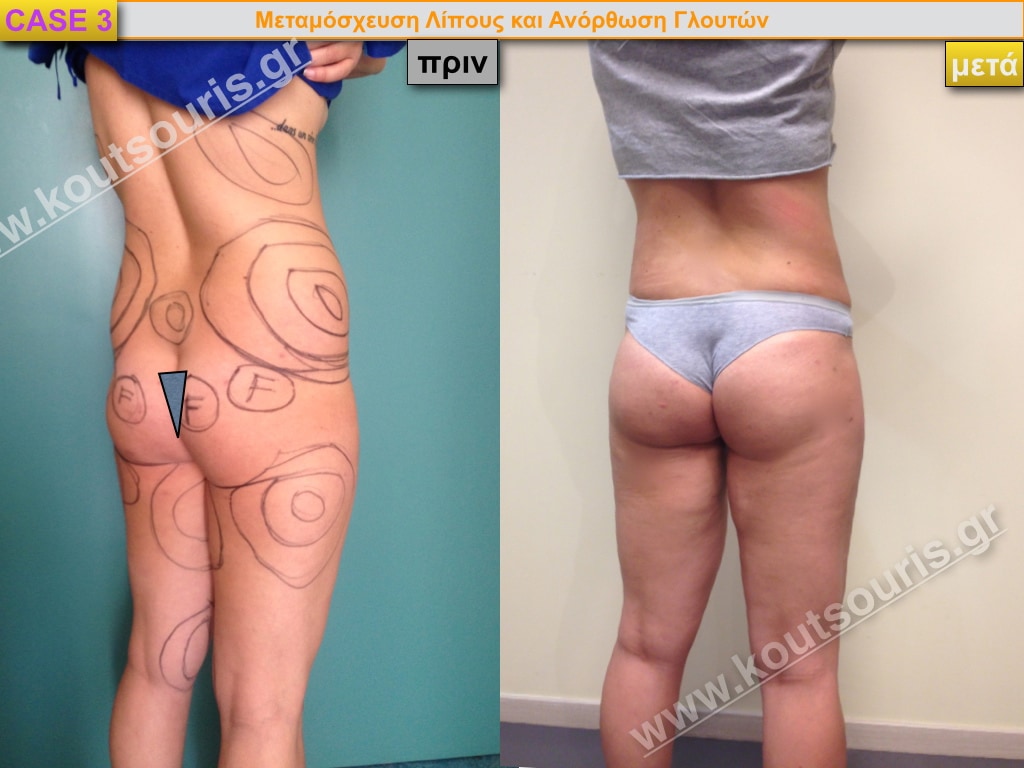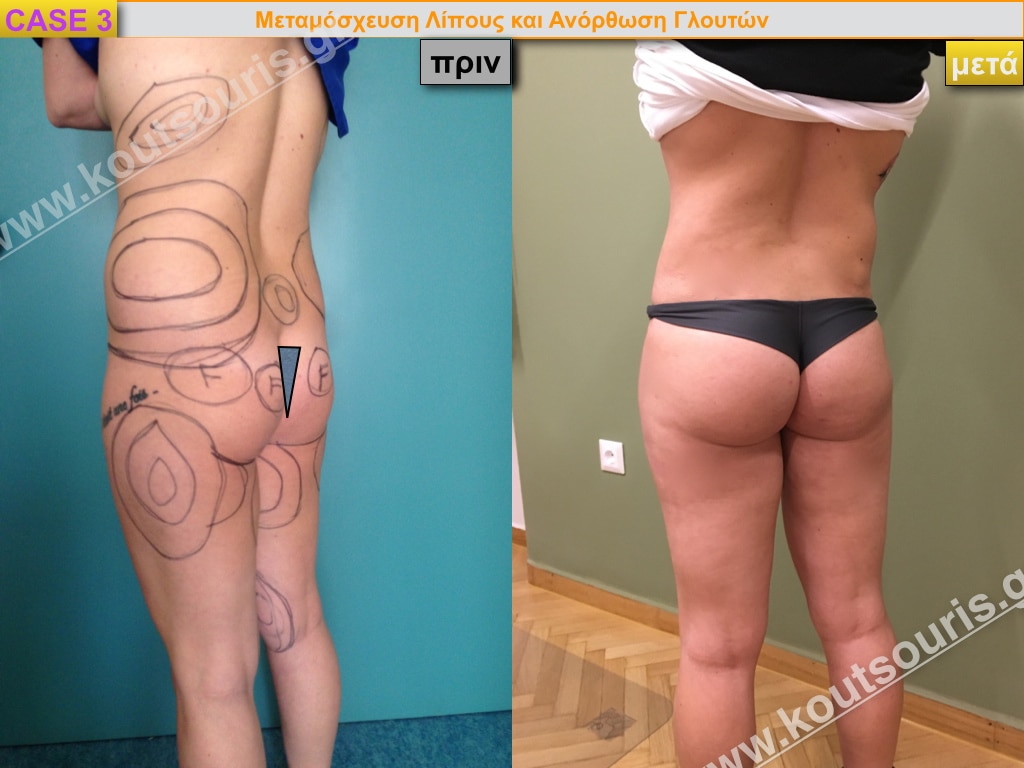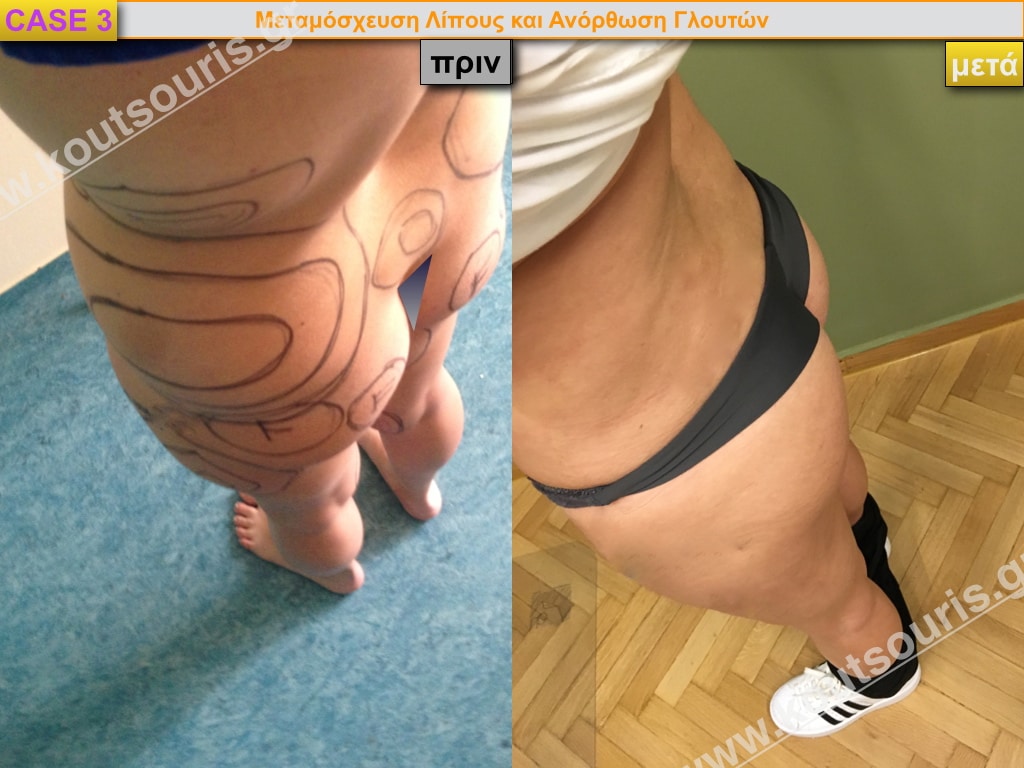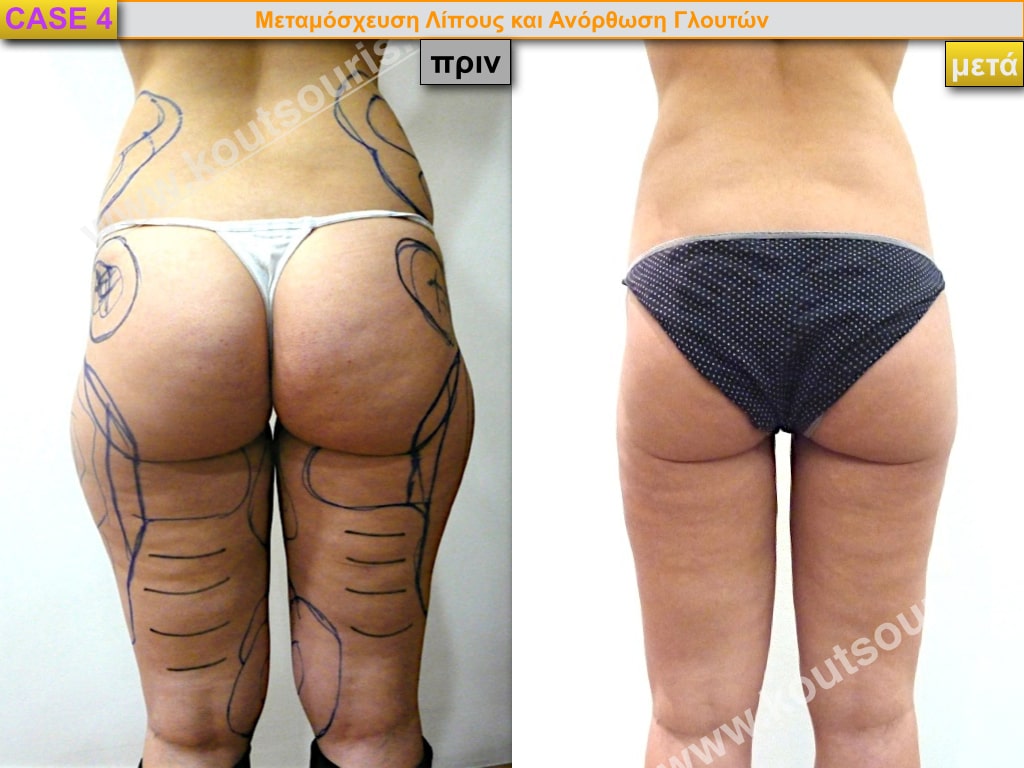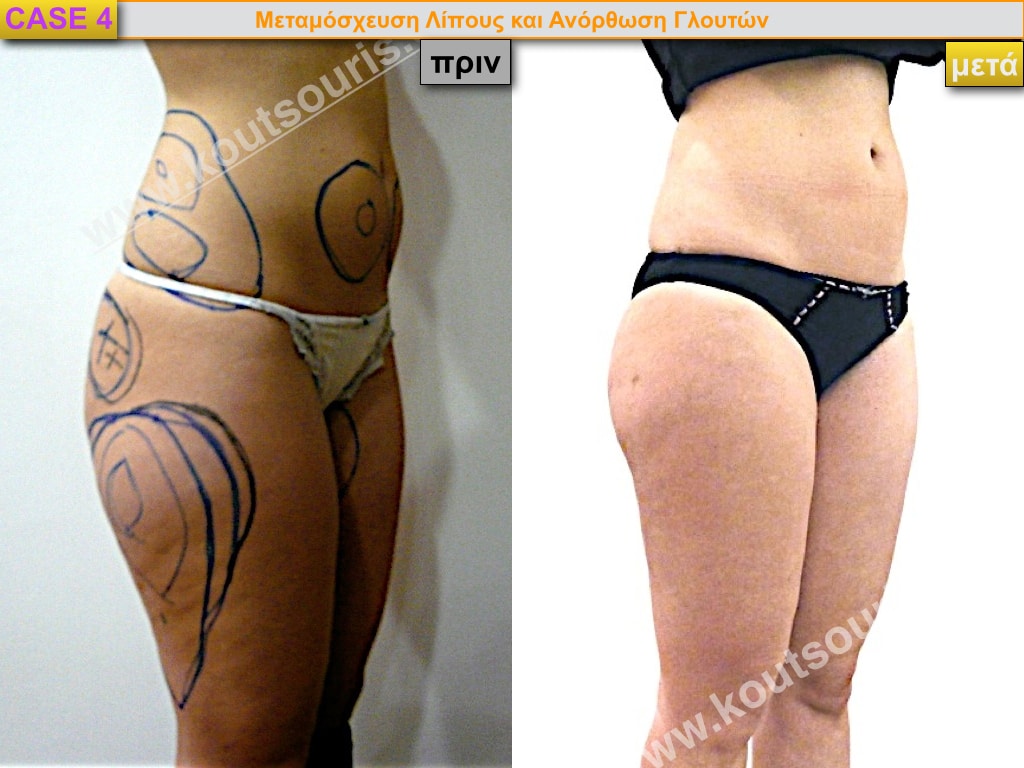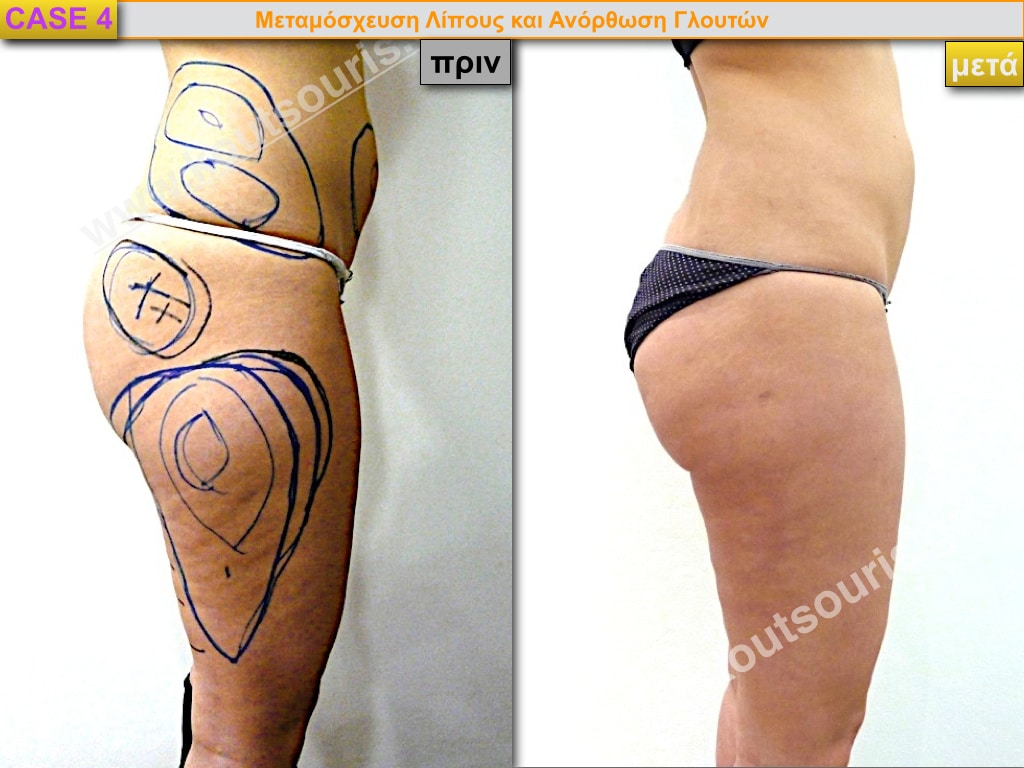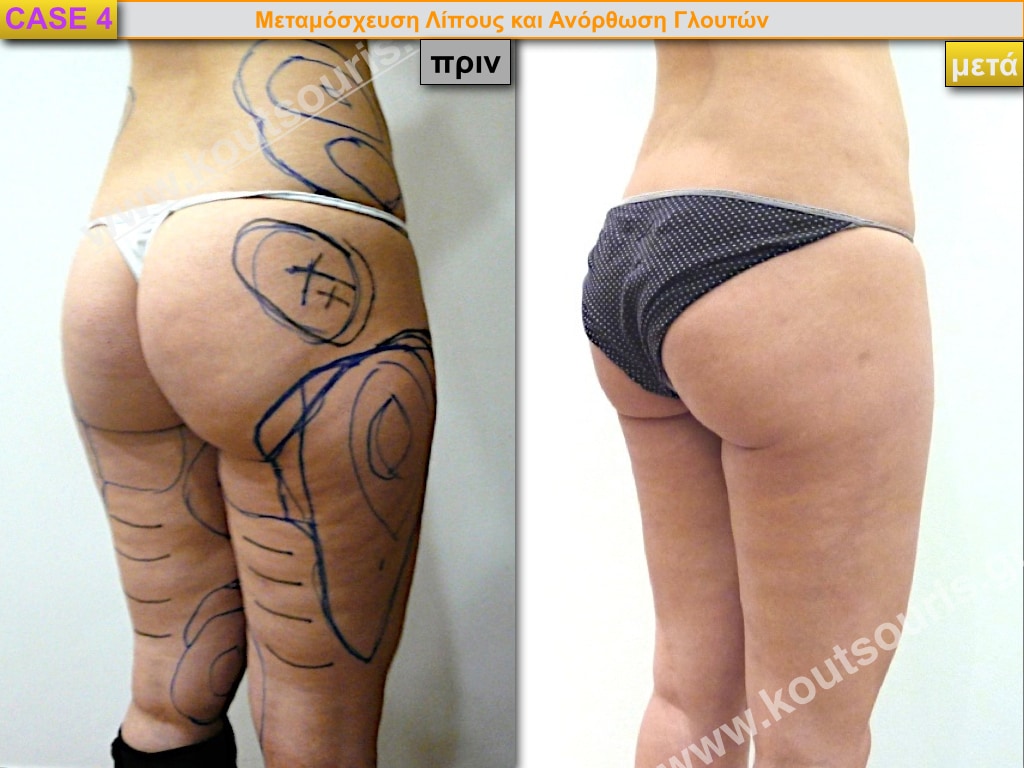BUTTOCK AUGMENTATION
Soft tissues’ loosening and fall in the gluteus area is an anatomic problem affecting many women and men, as well.
What we often observe when examining the gluteus area usually is a deficiency on the upper gluteus pole in conjunction with tissues displacement towards the lower pole. When combined with skin loosening, the area tends to look like a “deflated balloon”.
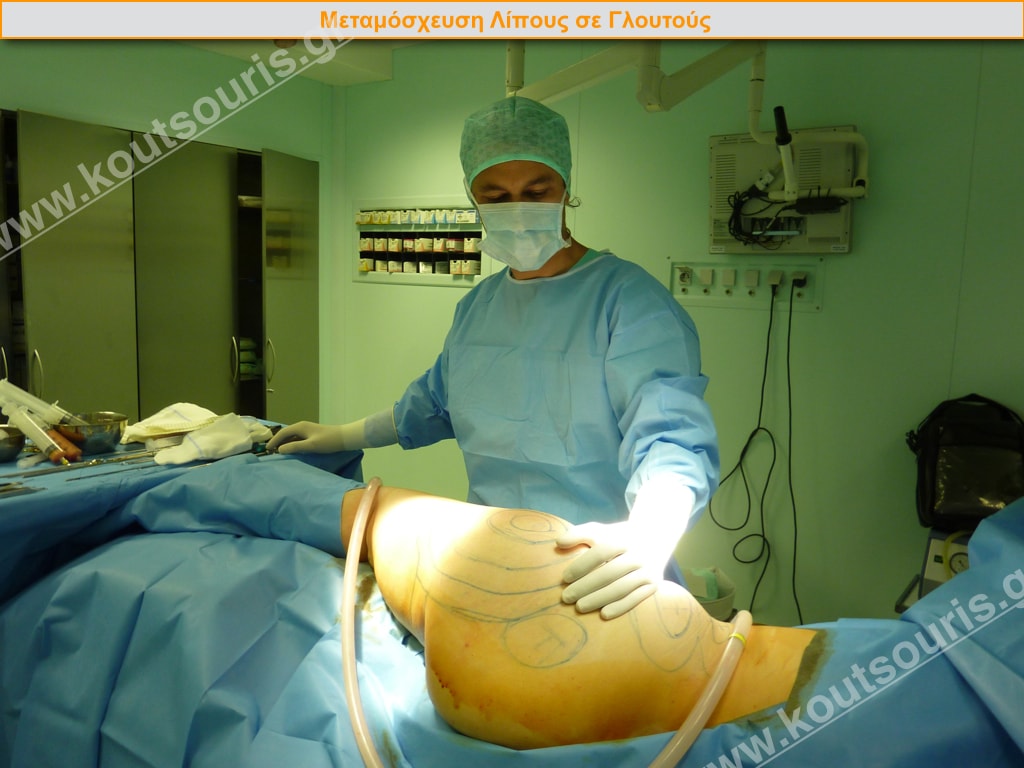
Therefore, the solution we resort to is filling the atrophic buttocks up.
Which ways can we augment or reshape the buttocks contouring?
Augmenting or improving the gluteus contouring can be achieved by:
1st. Fat grafting
2nd. Silicon inserts (of similar form to the silicon breast inserts)
3rd. Injectable Hyaluronic acid implant.
Which cases are the most suitable for Fat Grafting to the buttocks?
Fat Grafting to the buttocks aims at:
- Augmenting their size in the case of atrophic/small gluteus
- Correcting the buttocks’ shape as for instance in the case of deficit on the upper or exterior gluteus pole
- Improving the loosening and fall of the gluteus.
Who is eligible for a Buttock Augmentation with fat grafting?
It is primordial for the patient to have a sufficient fat quantity in his or her body so that we can proceed to fat transplantation to the buttocks. This is because we will then be able to extract the fat quantity needed for the operation.
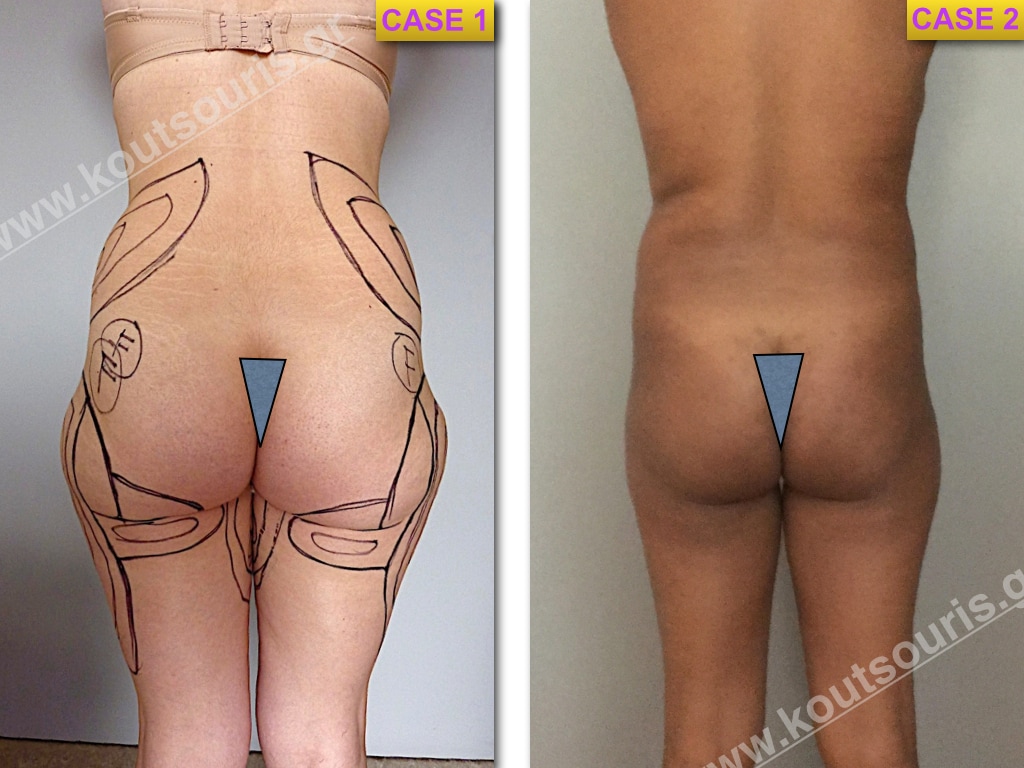
Given that 50-70% of the transplanted fat will be absorbed within three months after the surgery, a double or triple amount of fat should be extracted in every fat transfer operation. Thus, it is clear that underweight or excessively thin men and women are excluded from this treatment.
What type of anesthesia is applied when performing Buttock Augmentation with fat transplantation?
Fat transplantation to the buttocks is usually a long procedure with many technical particularities. The patient should remain calm and the surgeon should be very meticulous and methodical. On the one hand, we should extract a large amount of fat from the donor area(s) and on the other hand, we should transplant this fat in many areas of the gluteus.
This is the reason why general anesthesia is chosen.
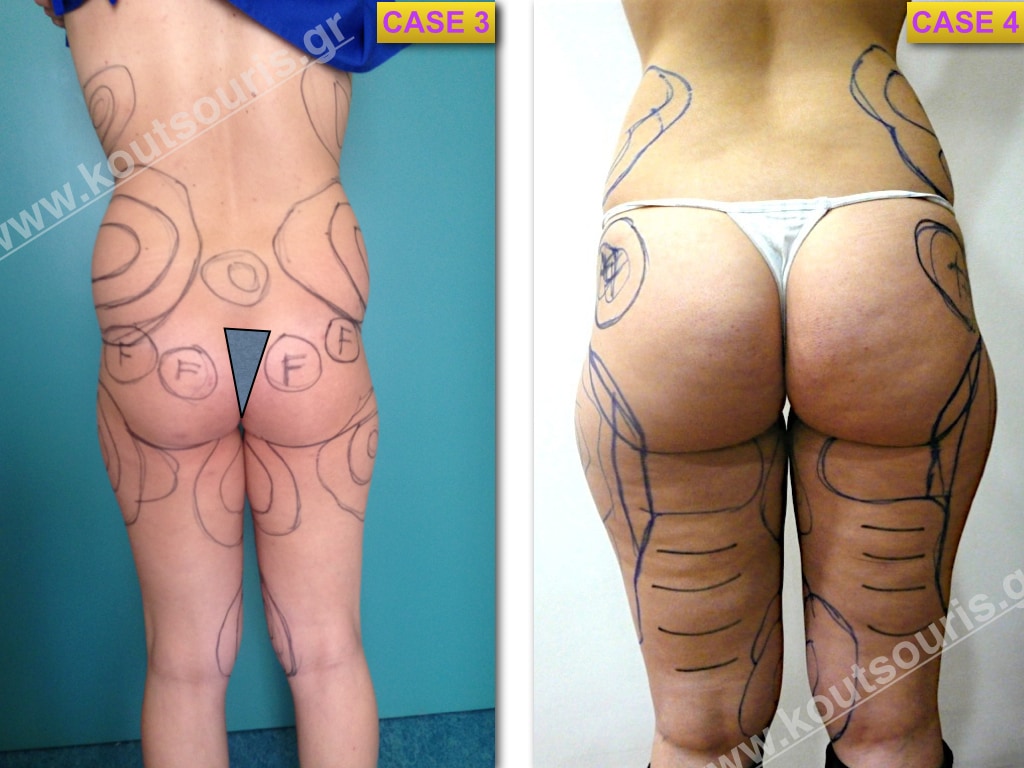
What is the procedure followed during the Fat Transplantation to the buttocks?
As in every case of Fat Grafting, the gluteal augmentation procedure is also divided into 2 phases.
We initially perform Liposuction (see 3D SAFELIPO) onto the DONOR areas. This is to say, we extract fat from the:
- Belly,
- Love handles,
- Inner thigh surface,
- Outer thigh surface,
- Inner knee surface,
- Saddlebags,
- Upper arm limbs.
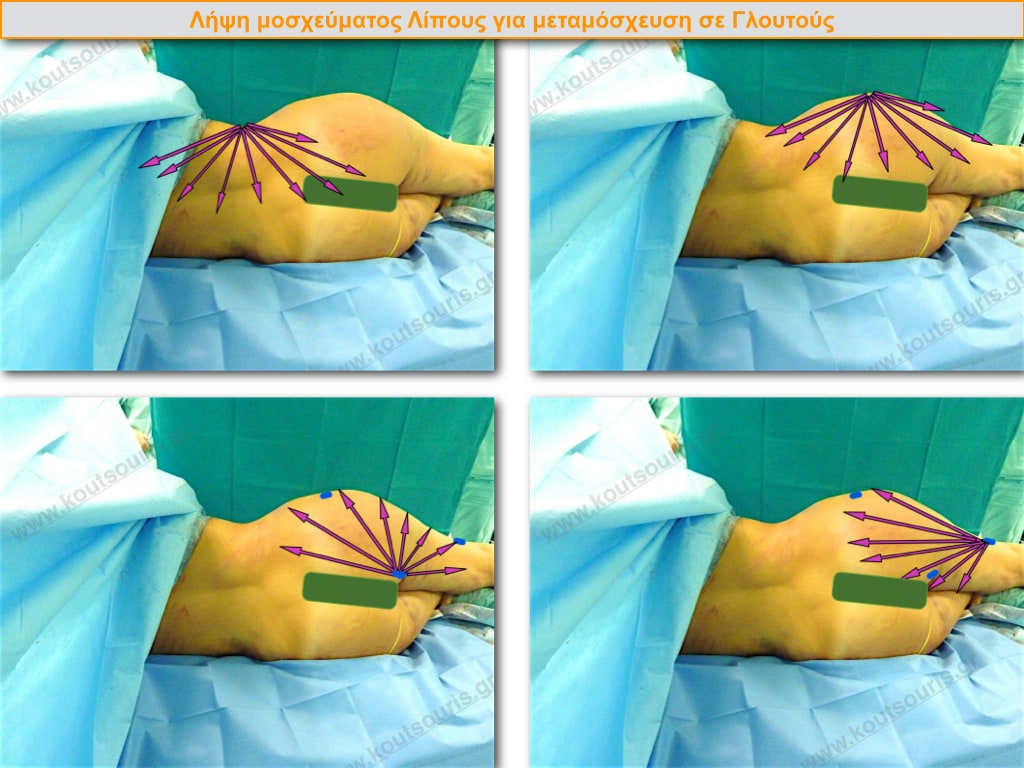
Then, the extracted fat is centrifuged under aseptic conditions, so that a large number of stem cells and structural adipocytes can be isolated and collected.
This fat is transferred into the RECEIVING area – i.e. inside the buttocks.
From a technical point of view, which way is Fat Grafting to the buttocks performed?
When performing Fat Grafting to the buttocks, we insert fat into several areas inside the gluteus.
Namely, using a special “cannula” we transplant fat:
- Deep inside the gluteus maximus
- Into an intermediate layer within the subcutaneous tissue of the gluteus
- Superficially into the upper layer of the subcutaneous tissue of the gluteus.
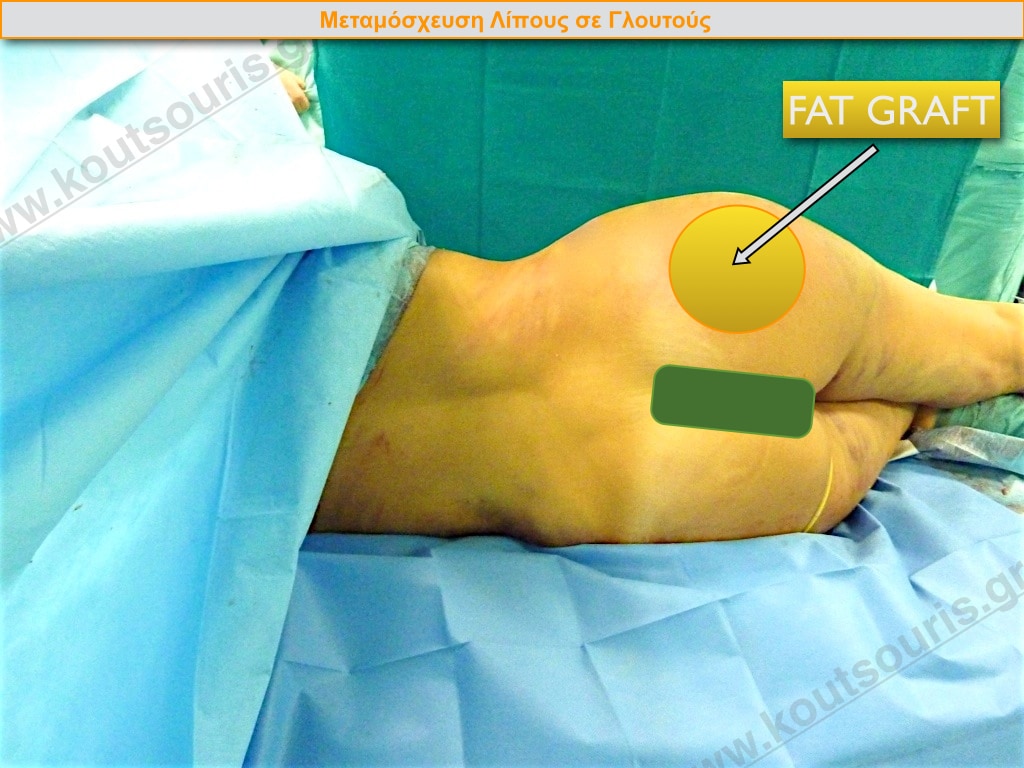
When performing fat grafting to the buttocks, we usually need 600cc to 900cc of fat for each gluteus.
As already mentioned, 50-70% of the transferred fat gets absorbed and is hence lost, thus the operation’s net transplanted fat will finally be around 300-450cc per gluteus.
In most cases fat grafting or buttocks contouring can be successful with a once-off treatment. On rare occasions a follow-up treatment might be needed, as long as there is enough fat to be transferred, of course.
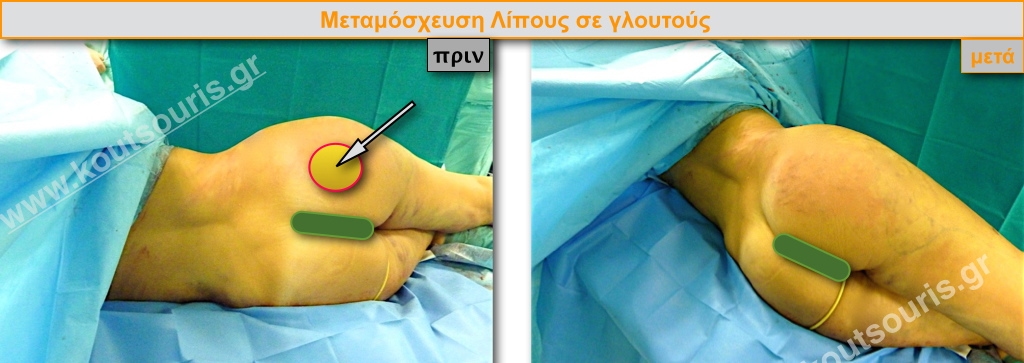
The fat grafting technique requires experience and technical skills during both extracting and transferring of the fat so that no large vessels and nerves are injured in the area of the buttocks.
When performing Fat Grafting to the buttocks, can we also lift them?
That’s right. The new Liposculpture technique is really innovative because on the one hand we can give volume to the area, and on the other hand we are able to lift the buttocks. This can be attained two ways:
1st. Transplanting fat in certain areas in the gluteus. We usually insert 130-250ml of pure fat in the upper outer quadrant so as to improve the curves and make the buttocks look more spherical, as well as 500-800 ml of pure fat into deeper gluteus areas so as to augment the size of it and make it project in a more aesthetic way.
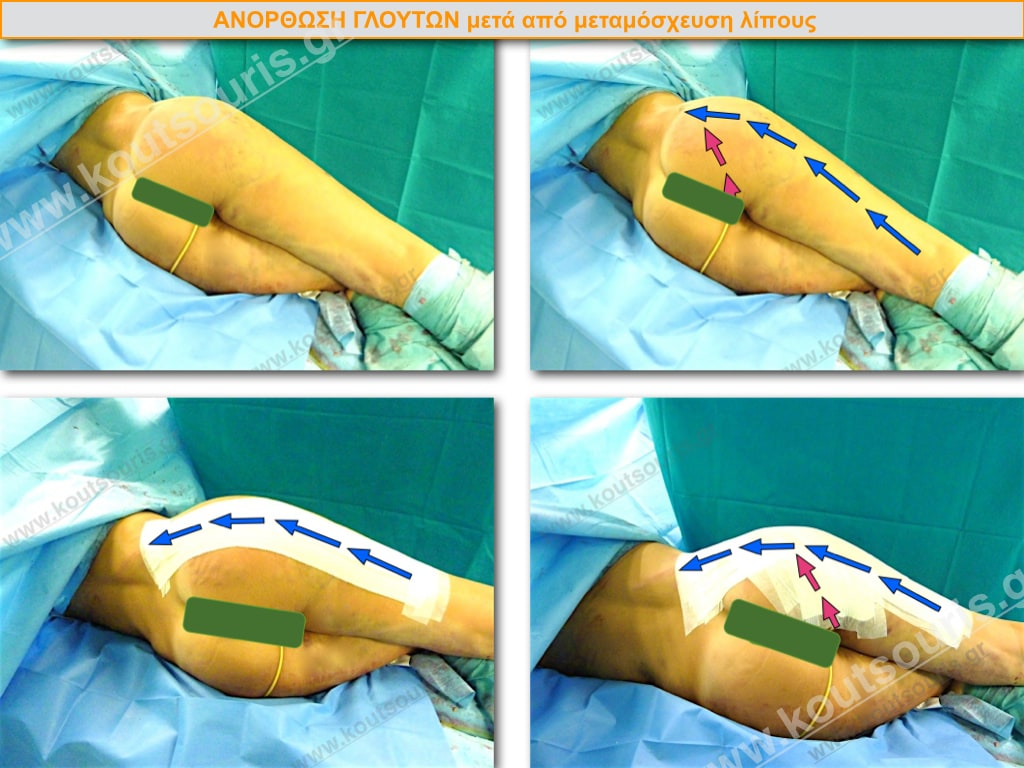
2nd. Placing a special elastic film in the gluteus side, which pulls the area’s skin onwards and backwards settling it in a new, higher position.
After the liposuction of the side gluteus area,the skin and adipose tissues have been detached from the more profound tissues. We can therefore lift the buttocks from 3 to 7 centimeters, due to the fact that the skin that has been detached during the liposuction is attracted by this special film and settles down in a new, 3-7cm higherposition.
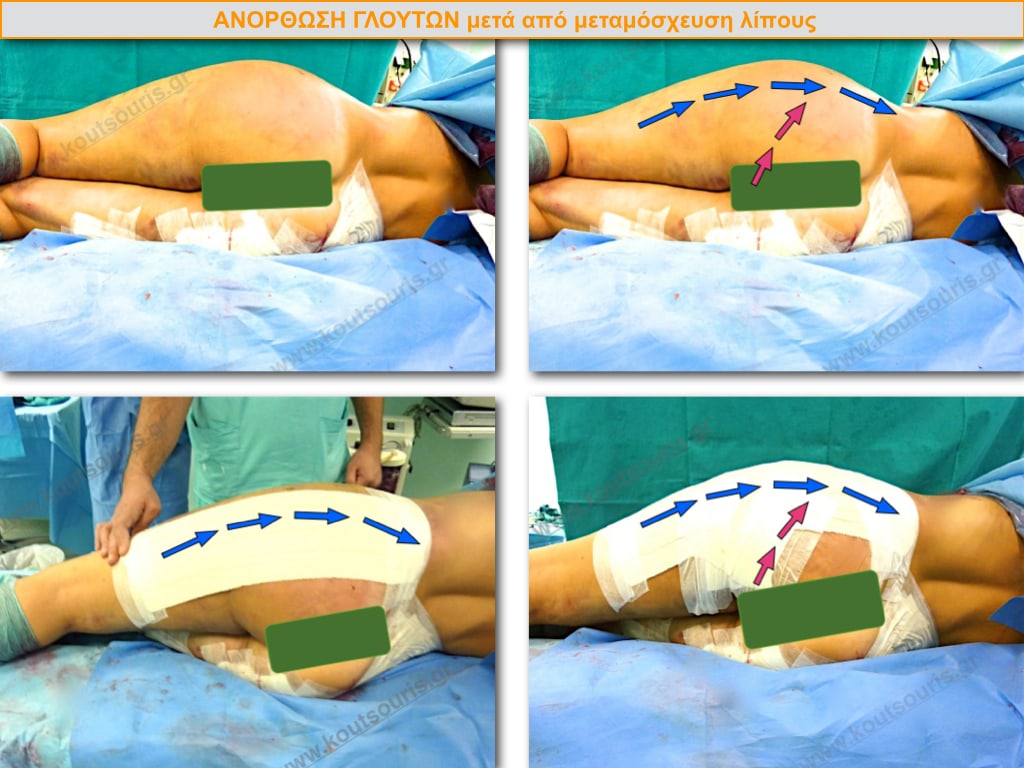
The elastic films remain on this position for 4 more days for the skin to “stick” onto its new position and the result of the buttocks lift is permanent.
What should we do RIGHT AFTER the Fat Grafting to the buttocks?
Right after the operation, the patient wears an elastic corset so as to hold the buttocks into their new, lifted position and protect the operated area from possible swelling formation. It is a liposuction corset, especially designed in a way that permits all kinds of activity.
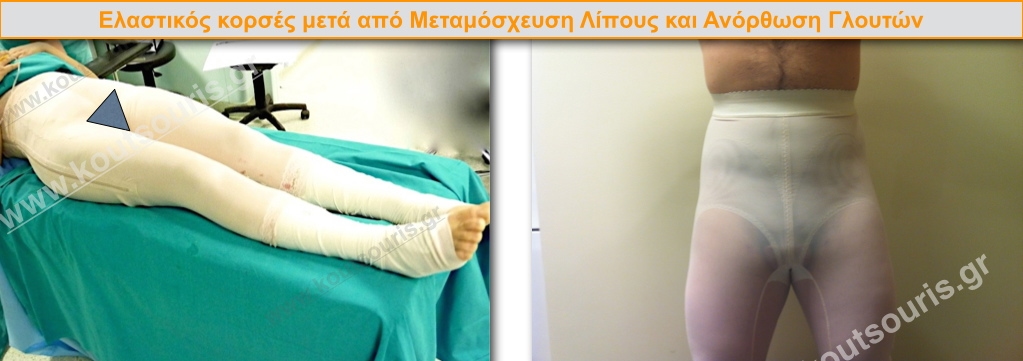
The patient is allowed to leave the clinic and return home under some restrictions right after the operation when correcting small surfaces of local lipodystrophy (usually with local anesthesia combined with intoxication).
However, in the case of small buttocks and several areas from which fat shall be extracted, the patient has to stay for 24hours in the clinic.
What should one do for the days to follow after the Fat Grafting to the buttocks?
The special films to lift the buttocks are removed in 4 days, whereas the corset must be worn by the patient for 15 consecutive days and, afterwards, for another month while taken out only during the night.
Post-surgically, swelling might be formed in the area where we have operated extracting the excess fat, as well as in the area to which we have transplanted it. This might be persistent for a couple of weeks.
This swelling after the surgery is solely based on lymphatic obstruction because of lymphatic vessels micro-traumas of the area and gradually recedes by the automatic restoration of said lymphatic vessels within a few weeks after the operation.
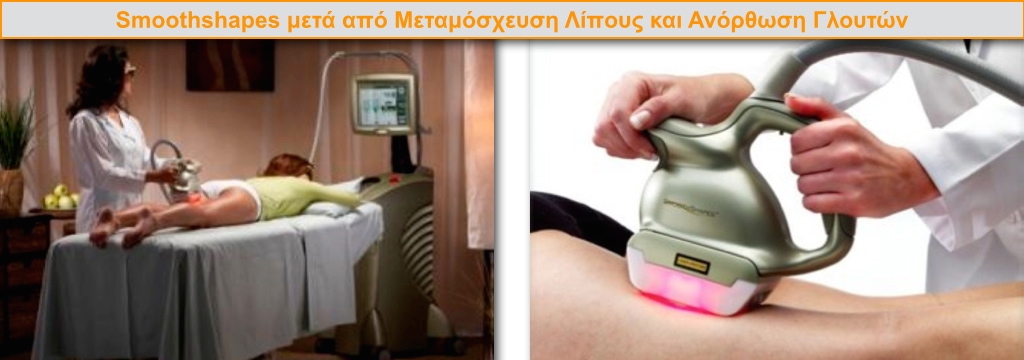
In order to accelerate the swelling’s healing, as well as to achieve an as homogenous as possible image of the skin and adipose tissue, we strongly recommend applying the LASER SMOOTHSHAPES.
This is a Laser which has been designed to treat the cellulite while being very beneficial after a Liposculpture treatment, as well. This is because it quickly removes lymphaedema, smoothens the treatment area and improves the cellulite (which more often than not co-exists with local lipodystrophy) state to a great extent.
Usually, two sessions per week are required for about 3-4 weeks. The treatment is applied both to the gluteus and to the donor areas.
Alternatively, we could apply lymphatic massage 2-3 times per week for about 3-5 weeks for the swelling’s treatment.
Both the Laser Smoothshapes and often lymphatic massaging make the cure after Liposculpting and Fat drafting to the buttocks impressively fast.
How will the buttocks area and the donor areas look like after the Fat Grafting to the buttocks? Might there be any pain?
When intervening with local anesthesia or intoxication so as to correct small surfaces of local lipodystrophy, then the treatment area usually feels numb or esthesiodermia and a mild swelling. Seldom does it hurt or annoy. It doesn’t even need painkillers most of the time.
Due to the fact that during Fat Grafting to the buttocks we intervene in several body areas so as to extract transplant-fat (Full Body Liposculpture), we usually experience a mild swelling as well as bruises post surgically on the donor areas. The swelling and bruises gradually recede (relatively fast) within about 7-10 days.
There also is swelling in the area of the buttocks which recedes in about one and a half to two months, as buttocks gradually finalize in shape.With regards to the pain, due to the fact that during transplantation we intervene to several areas and in fact perform a radical body reshaping, there might be a mild nuisance or even a mild pain for the first one or two days, which can be though completely alleviated with painkillers.
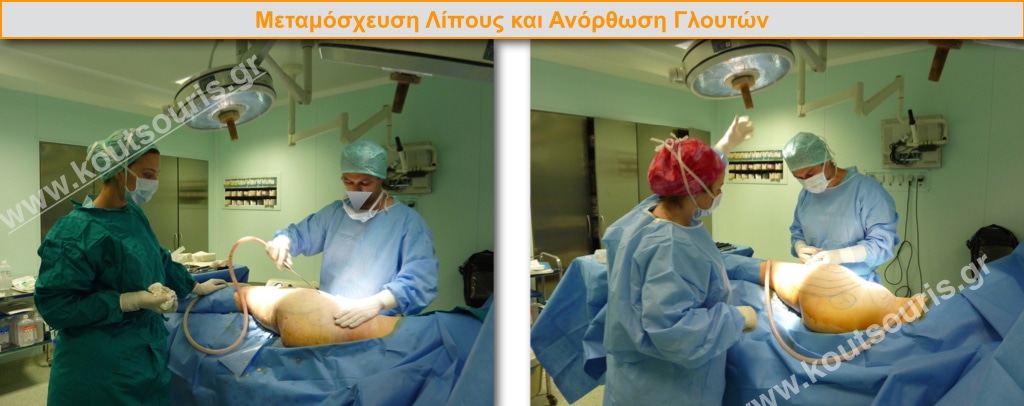
The nuisance or pain completely recede after day 3-5, hence it’s time to stop the intake of painkillers and the only thing that the patient might fell is a little numbness or esthesiodermia that might last about 3-6weeks. We should always bear in mind that even right after the surgery, the patient does not feel any pain at all – only feels numbness or esthesiodermia. However, when in motion, the patient might experience nuisance or mild pain, which can be totally alleviated with common painkillers.
Might there be any side-effects or implications after a Fat Grafting to the buttocks?
Fat Grafting in order to increase or reshapethe contouring of the buttocks is a safe technique when performed in an organized surgical environment, by certified Plastic Surgeons and under the fundamental principles of Plastic Surgery.
The most frequent case after Fat Grafting to the buttocks is bruises and swelling, which both gradually recede within 2-3 weeks.
Furthermore, there might also appear post surgically some numbness or hyposensitivity in the area of liposculpture, which gradually recedes and is totally restored in the next few weeks.
After liposuction for fat extraction, seroma might be formed. This is a collection of fluid that builds up in the DONOR area as a result of lymphatic obstruction. The fluid collection might last about 2-3 weeks and consists an adverse event rather than an implication. It is simply treated by discharging the lymphatic fluid.
Skin traumas are in general not frequent and are treated with local care.
After a Fat Grafting, it is pretty rare that inflammation or hematoma be formed, which can be immediately treated by discharging the fluid and antibiotics administration respectively.
Another possible implication usually after several weeks or even months from Fat Grafting to the buttocks is the formation of small cysts with oily content inside the gluteus mass. These oily cysts appear because of fat melting and their usual treatment simply is puncture at the clinic’s premises.
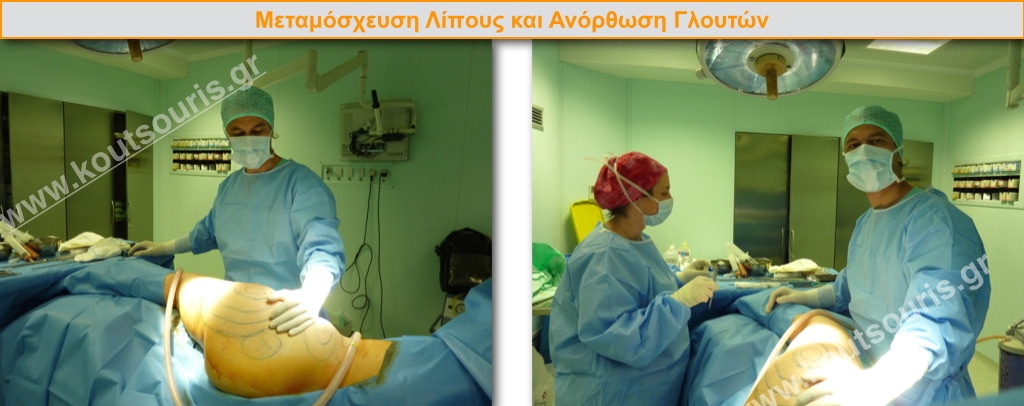
Due to the absorption of a part of the transferred fat by the organism, another problem that might arise after the Fat Grafting to the buttocks might be some mild asymmetries in the area. In such case, we usually amend the issue after 5-6 months, more often than not with local anesthesia.
All along the surgery of Fat Grafting to the buttocks, the surgeon must be transplanting fat to anatomically safe areas in the gluteus. Given that the area is being supplied by large vessels and neurons, one should avoid injuring these vital organs. In case of injury of those large vessel branches, a pulmonary fat embolism is very likely or lower limbs nerve palsy. Those are two very serious implications which thankfully are pretty rare.
Human atrophies and tissue deficiencies’ restoration with the use of fat extracted from an area of the torso and transplanted to another, is a contemporary and highly effective surgical treatment. Nonetheless, as happens with every new technique, it has some advantages and some drawbacks.
What are the advantages of Fat Grafting?
Fat is a very sensitive tissue and the grafting treatment requires vast experience and meticulousness from the Plastic Surgeon.
However, due to the fact that the transferred Fat to be grafted during the operation is OUR FAT, this technique has exquisite results, such as the following:
- No allergies caused
- No foreign body reactions caused
- No hypersensitivities caused
- No malignancies caused
- Too low inflammations percentage (since a proper aseptic technique is followed)
- Too low infections percentage (since a proper aseptic technique is followed)
- Tissue regeneration (because of stem cells contained in high concentration in fat)
- Relatively low cost
- Permanent results.
The transplanted fat is structural, thus abiding by the reserve fat rules.
2-3 months after settling down to its application position (given that it is not absorbable any more) it gives a PERMANENT or LONG-LASTING solution to the problem of tissue increase.
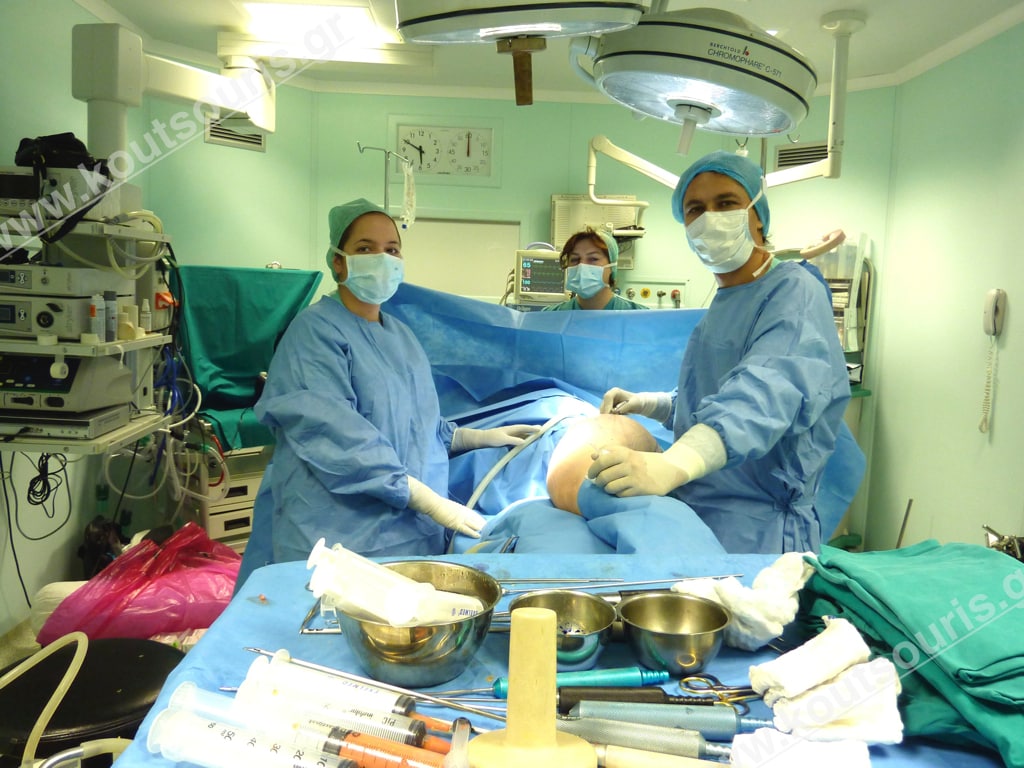
The above properties make Autologous Fat a high-quality implant for the human body’s atrophies or deficiencies correction.
This is the reason why those last few years there has been much talk in the scientific and research community on the fat extraction, transfer and infusion.
What are the drawbacks of buttocks augmentation with fat transplantation?
The Buttock Augmentation with Fat Transplantation has certain drawbacks:
1st. Due to the fact that a 50-70% of the transplanted fat is absorbed, we should transplant double or triple fat quantity so as to attain the desirable rise in volume. This practically means that if the patient does not have sufficient fat then we cannot attain the desirable result and will therefore have to look for an alternative buttock augmentation treatment.
2nd. If we want a very big increase of the buttocks size, more than one sessions might be required.
3rd. Small fat cysts might appear after the fat transplantation to the buttocks due to fat melting. They require diagnosis and a surgical solution – usually diagnostic puncture.
4th. Because the transplanted fat is structural fat, any increase or decline of its quantity over the years, will be noted in the transplanted area.
What are the pros and cons of Buttock Augmentation with silicone insets?
One biggest advantage of buttock augmentation with silicone insets is that they can be applied to any body type and that the gluteus area reforming is immediate. It is the basic treatment method for thin individuals – people with scarce adipose tissue – or extremely loose skin.
The drawbacks of Buttock Augmentation with silicone inserts are:
- It is an admittedly painful procedure,
- It requires a long curing period given that the patient is not allowed to sit for 1-3 months postsurgically. This is because the inserts should not be pressed and hence be misplaced, right after the operation,
- Since the silicone inserts are foreign bodies in the organism, there always lies the risk of an inflammation or infection. Given that the placement of silicone inserts is performed via an incision on the intergluteal cleft, near the anus, the infection rate generally is higher compared to that of other operations,
- Due to the inserts being placed under the muscles, there is a risk of breaking or moving to an undesirable position causing asymmetry or malformation to the area,
- A “capsule” might be postoperatively formed, i.e. a reactive adhesive film around the insert (just like in the case of breast silicone inserts), and requires surgical treatment.
Consequently, we can affirm that although some very satisfactory aesthetic results, buttock augmentation with silicone inserts has the drawback of a high rate of implications and adverse events that can even reach 60%.
What are the pros and the cons of Buttock Augmentation with injectable Hyaluronic acid implant?
Both the advantages and disadvantages of buttock augmentation with the use of injectable Hyaluronic acid implant are the reason why Hyaluronic acid is an exceptional implant for human tissues.
The Hyaluronic acid is a completely non-active substance which means it is not causing any allergies nor triggers any reactions, forms inflammations, causes malignancies nor forms collagenoses. What is more, it does not tend to move, so it stays where initially transplanted maintaining the desirable result for a long time.
Hyaluronic acid is THE ONLY plastic surgery IMPLANT that has an ANTIDOTE. This simply means that “in case I don’t like something” after Hyaluronic acid has been applied or if there is any kind of deformation from a wrong application, then there always is an option of using its ANTIDOTE substance to remove the excess or misplaced material, restoring the image 100%.
The Hyaluronic acid application procedure is also pretty simple. No surgery is needed for the implant to be inserted – this is usually performed under aseptic condition in the clinic (just like all the injectable face treatments). It is almost painless, given that it is performed under local anesthesia and it is fully controllable by the surgeon.
The drawbacks of the buttock augmentation with injectable Hyaluronic acid could be:
- The fact that it is an absorbable material. This means that it has no permanent results and its application should be repeated after some time,
- Given that it is a different material from the human hyaluronic acid, there is always a risk of a hypersensitivity reactionbecause of the foreign body. In such case, the implant should be removed,
- There is always a risk of inflammation or infection,
- It is significantly costly, mainly due to the big quantity of the material needed.
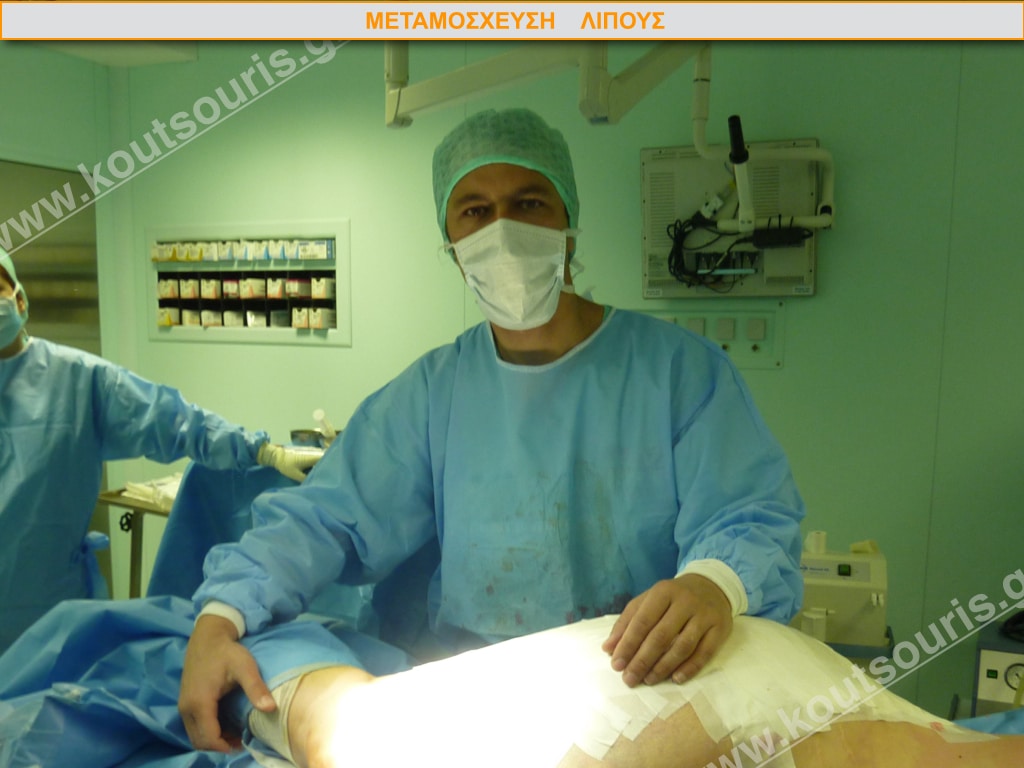
Taking all the above into consideration, it is clear that BUTTOCK AUGMENTATION with FAT TRANSPLANTATION is the most contemporary and innovative method for the atrophic, saggy and flabby gluteus.
FAT TRANSPLANTATION is a secure method characterized by effectiveness and constitutes nowadays the METHOD OF CHOICE for the BUTTOCK AUGMENTATION.
Μεταμόσχευση Λίπους και Ανόρθωση Γλουτών
ΠΕΡΙΣΤΑΤΙΚΑ ΠΡΙΝ & ΜΕΤΑ
